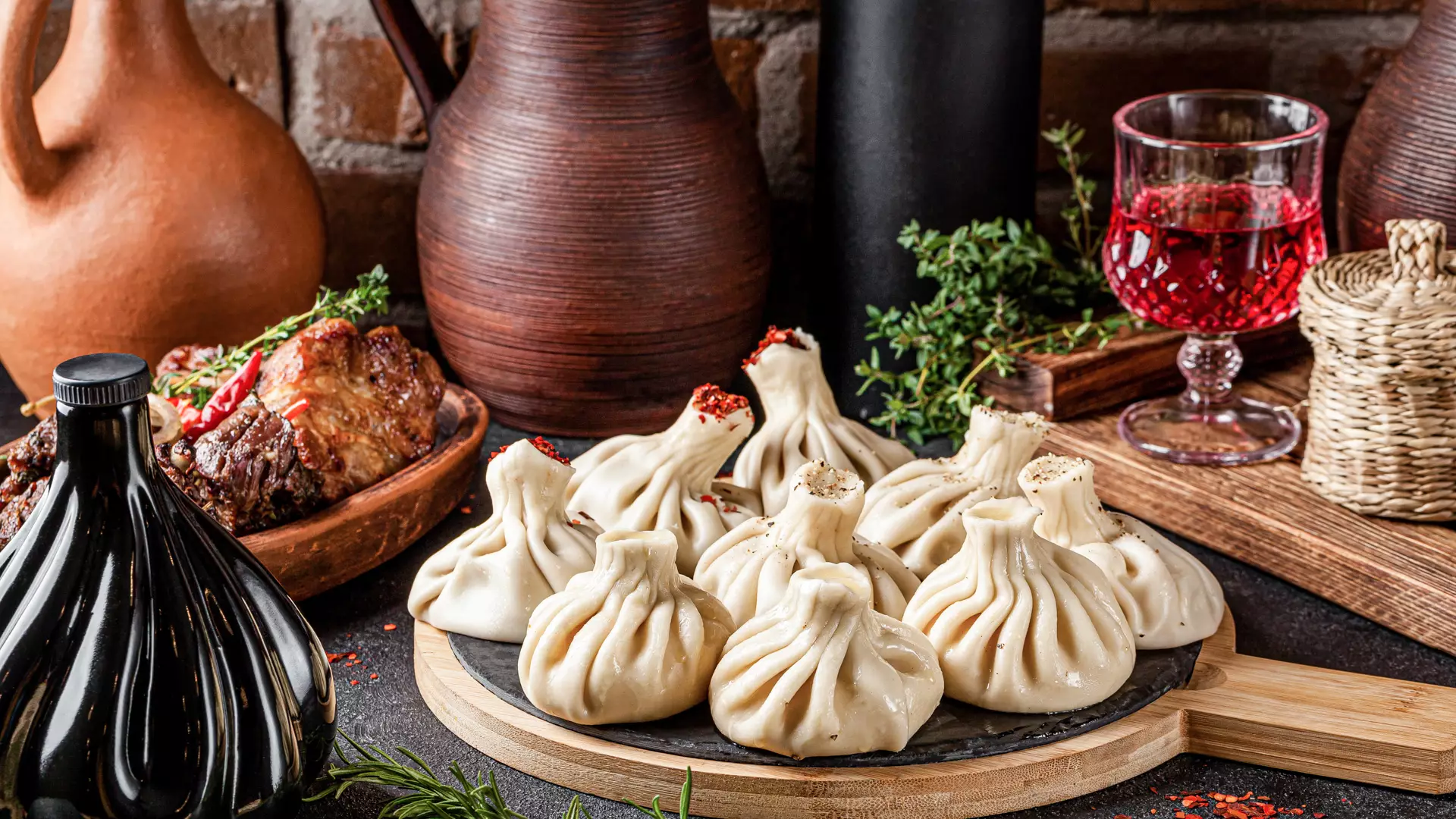Khinkali
Some people compare khinkali to small sacks tied off at the top, some say that it is the size of a tennis ball, and others try to find parallels with Ukrainian varenyky. There are even those who suggest that it was brought to Georgia by the Mongols and was created under the influence of Chinese culture. You may read that the word “khinkali” has its origin in Dagestan, from internet publications.
While the world debates the origin of khinkali, Georgians know for sure that khinkali is the child of Georgian cuisine, that its shape resembles the sun, and the folds made by closing it up are a borjghali – a sacred ornamental Georgian symbol.
Khinkali and Georgia
In Georgia, khinkali is not just a part of the cuisine, but also a tradition and an inseparable part of the culture of the country.
In the mountains of Georgia, it is considered to be a dish symbolizing an offering to the sun, prepared on Sundays and on holidays with the borjghali as a symbol of the unending motion of life. They believe that khinkali must have 28 folds to represent the years of the solar cycle as the sun completes its full journey around the sky. A famous Mtiuletian poem stated, “O, poor cottage cheese khinkali, with 28 folds”, each crease of the borjghali signifies the sun’s rays. Our ancestors made khinkali on Sunday or the day of the sun in Old Georgian.
In the mountainous regions of Georgia, you will hear many legends about khinkali and the story of its creation. The most widespread one is that of the wife of a high priest named Khinda. As a sign of respect for a guest, she made this meat dish, and her creation was so well-appreciated, it was named in her honor – “khindali” – which, over the course of time, became “khinkali”.
Another version says that it was called “lkhinkari” (“feast door” in Georgian) because it was made for festivals and as an offering to the sun.
How to Make Khinkali
Nowadays you can try khinkali in nearly every region of Georgia, but Pshavi and Tusheti are considered its homeland, from where it spread to the rest of Georgia. At first, it was made with mutton and served very hot, making it an ideal dish to eat during cold winters.
As soon as khinkali moved out of the mountains and into the valleys, the city started making changes to it. The mutton was replaced with a mixture of pork and beef, and minced, ground meat was preferred. Thyme, which was hard to find in the city, was replaced with cumin, herbs were added to the onion and pepper, and so the recipe for kalakuri khinkali was born. However, in popular khinkali restaurants, you can order any recipe.
One of the most widespread recipes for khinkali looks like this:
- 1 kg high-quality bread flour;
- 600 g beef;
- 400 g pork;
- 2 onions;
- 1 tbsp salt;
- 1 medium-sized bunch each of coriander and parsley;
- Black pepper, coarse-ground red pepper, to taste;
- ½ tsp cumin.
Sift the flour in a deep bowl and occasionally pour cold water into it. Add one tablespoon of salt and knead the thick, but soft, dough. Move it to the bowl, cover it with a towel, and leave it in the refrigerator for half an hour. Knead it again and leave it for another 10 minutes.
Put the meat, onions, and herbs through a meat grinder, add the black pepper, coarse-ground red pepper, cumin, and salt, then slowly soften it up with water until a spoon can gently sink to the bottom.
There are special, wooden cups for cutting khinkali dough, but if you do not have one, use a regular, thin-lipped cup. Cut out small balls from the flattened dough, roll them in the flour, and flatten them more. Put a spoonful of ground meat into each one, close up the top, cut off the excess dough, and put them into boiling salt water with the top downward.
While it is boiling, shake the pot by the handles. When the khinkali floats up to the surface of the water, give it ten to fifteen more minutes, then take them out to rinse them with a small amount of cold water, so the khinkali does not stick together.
Variations of Khinkali
You can eat khinkali with cottage cheese, goose apokhti, cheese, potato, mushroom, and even modernized variants with shrimp.
Khinkali is usually eaten with beer, as brewing beer was more possible than making wine in the mountains of Georgia. Eating khinkali with your hands and slurping out the juices so that not a single drop is spilled is essential to make the most of this delicious dish.
Cookie Policy

